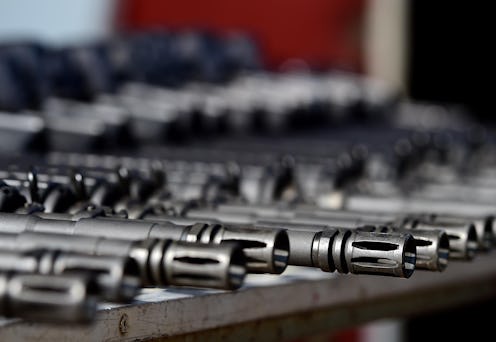On Tuesday, President Obama called on Congress to reinstate the Federal Assault Weapons Ban that was in place between 1994 and 2004. His statement precedes his visit to Orlando, Florida, which is scheduled for Thursday. Sunday morning's massacre at the gay nightclub Pulse took the lives of 49 innocent victims in what is the largest mass shooting in American history. The atrocity impassioned gun control advocates to promote an assault weapons ban and stricter gun control laws. Their requests may become a reality if Obama exercises his executive power. If re-enacted, what would the Federal Assault Weapons Ban do?
Otherwise known as the Public Safety and Recreational Firearms Use Protection Act, the ban was enacted in 1994 and makes it illegal to "manufacture, transfer, or possess a semiautomatic assault weapon." It also limits magazines' carrying capacity to 10 rounds of ammo. However, the mandate doesn't apply to semi-automatic arms that were already owned or transferred legally prior to May 16, 1994, the date the bill was passed.
Under the ban, the AR-15 — the gun used in the Pulse Orlando shootings, Sandy Hook, the Aurora, Colorado, movie theater shooting, and the San Bernardino attack — would be outlawed. Though the bill lists which makes and models will be affected by the ban, it doesn't provide an overarching definition of the term "assault weapon." For example, one definition includes "a semiautomatic rifle that has an ability to accept a detachable magazine" with at least two of five listed characteristics. The functioning of a semi-automatic gun is more straightforward to explain: It shoots one round when the trigger is pulled and automatically re-loads the next round.
Ultimately, a semi-automatic gun is only considered an "assault weapon" if it has certain additions, such as detachable high capacity magazines that could potentially allow an attacker to shoot more consecutive rounds. Thus, the bill is essentially a ban on additional features or on guns that come equipped with these features already; it will not stop people from using semi-automatic weapons.
In 1999, the National Institute of Justice released a research report that studied the effects of the ban. It succinctly explained why, at the time, Americans felt it was important to target semiautomatic assault weapons exclusively.
Although the weapons banned by this legislation were used only rarely in gun crimes before the ban, supporters felt that these weapons posed a threat to public safety because they are capable of firing many shots rapidly. They argued that these characteristics enhance offenders’ ability to kill and wound more persons and to inflict multiple wounds on each victim, so that a decrease in their use would reduce the fatality rate of gun attacks.
Though the ban's direct impact on overall gun violence is unclear, it's possible that it could have minimized mass shootings, The Washington Post reported. Before 1994, mass shootings occurred rarely. Between 1994 and 2004, when the ban was in place, they happened even less often but it's difficult to tell which factors directly contributed to the decline. Perhaps the strongest argument for reinstating the ban will be the fact that mass shooting have doubled since it was lifted.
This isn't the first time Obama has called for an assault weapons ban. Days after 20 children and six adult staff members were shot at Sandy Hook Elementary School in Newtown, Connecticut, the president responded by promoting a ban on assault weapons and high capacity magazines. He told White House reporters at the time that enough was enough.
This time, the words need to lead to action. We know this is a complex issue that stirs deeply held passions and political divides. ... But the fact that this problem is complex can no longer be an excuse for doing nothing.
Ultimately, the bill flopped after Republicans questioned how effective it was in preventing similar scenarios in the past. Three years later in December 2015, House Democrats revived their efforts. A number of mass shootings, most recently the San Bernardino and Colorado Springs Planned Parenthood attacks, had occurred since Obama made the original push to reinstate the ban. Though it was supported by 90 House Democrats, The Hill reported, it, too, failed to convince Republicans.
The assault weapons ban makes it sound as if any gun resembling a military weapon will be outlawed —but that's simply not the case. Though the piece of legislation certainly limits the types of guns that can be bought and manufactured, it's wrought with loopholes. And in the midst of a heated national debate over gun laws, convincing Republican House members that "assault weapons" — which haven't been coherently defined by the government — are more dangerous than common semi-automatic hunting rifles and pistols will be a challenge for Obama and the bill's Democratic sponsors.
